TEXT AND DIGITAL MEDIA: THE VISUALIZATION OF CODE, CODEX AND CONTEXT
ABSTRACT
The changes in the definition of text and image caused by contemporary digital media have altered the traditional concepts of political and social hierarchies as well as blurred the boundaries between text based and image based disciplines. The concepts of interdisciplinarity and transdisciplinarity as well as those of transnationalism and multiculturalism offer insight into the relationships that have developed between disciplines within both global and local contexts.
These relationships are framed within a digital media structure based on processes of mediation, remediation and transmediation that reflect the digital transformations that have blurred the boundaries between classic and new media (Lev Manovich; Henry Jenkins).
In this context literary works are no longer part of a standalone discipline but can be visually represented in multiple visual formats, both digital and analogue. The text itself with its context, real and/or virtual, becomes a visual structure that can be manipulated and engaged with beyond its original purpose and transferred as text across multiple platforms. The artwork La Plissure Du Texte (1983) by Roy Ascott – a global telematic, electric and distributed narrative – is an example of the transformation of the relationship between text and visuality as the artwork is transmediated from its original telematic concept for the Venice Biennial (1986) to a new version in Second Life for NABI in Seoul. The merging of textuality and images increasingly become – particularly in virtual world – an architectural texture that defines spaces and interactions evidencing the process of transformation of the relationships between text and image.
The essay will demonstrate, through examples of visual contemporary artworks and artistic practices, how the richness of contemporary digital media offers the opportunity to create images from literary texts that, having originated as written word, are transformed into digital artworks that can be transferred into analogue formats.
This analysis will conclude by arguing the relevance and vitality of literature within the contemporary digital hybridization processes which display words, as both textual and visual artworks, as well as stress the ruptures in the socio-political hierarchies that these unorthodox practices generate.
KEYWORDS
Mediation, remediation, transmediation, virtual, text, context, codex






